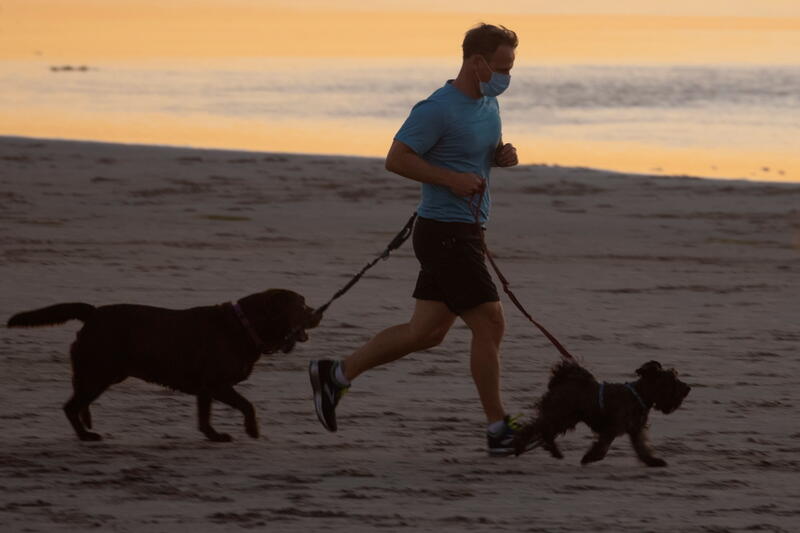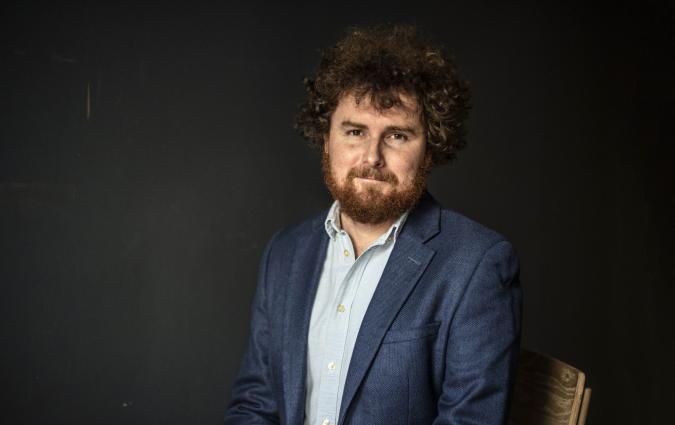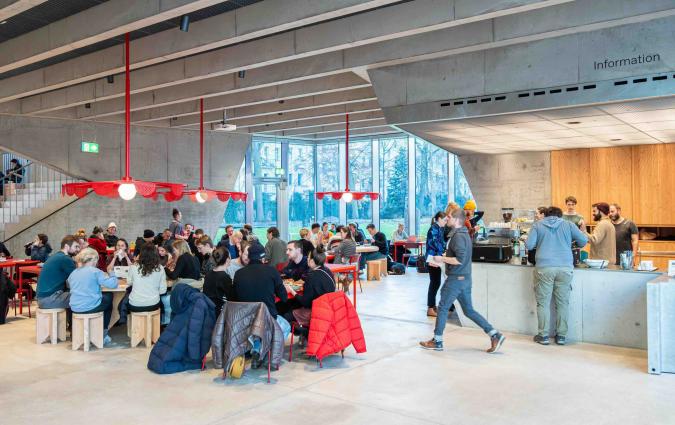Our podcast: How premium lifestyle journalism sells subscriptions

A man wears a face mask as he exercises with his dogs in Del Mar, California, U.S., December 1, 2020. REUTERS/Mike Blake
The topic
COVID-19 has been watched very closely by those interested in policy and science news, with journalists covering governmental responses, the impact on healthcare infrastructure and the race to create and implement vaccination programmes. But the pandemic has had a profound impact on our daily lives. In this episode of our podcast we talk to two journalist fellows from some of Scandinavia's largest media houses about how lifestyle journalism sits within publishers' wider strategies.
The speakers
Host:
Meera Selva is the Director of our Journalist Fellowship Programme, the Deputy Director of the Reuters Institute, and an accomplished senior journalist with experience of reporting in Europe, Asia and Africa.
Guests:
Jenni Kangasniemi works as a producer at the Lifestyle department of Helsingin Sanomat newspaper and wellness magazine Sport, specializing in health and science content. She is a Journalist Fellow at the Reuters Institute.
Evelyn Jones is a features reporter at Sweden's biggest morning paper, Dagens Nyheter. She is a Journalist Fellow at the Reuters Institute.
The podcast
On Spotify | On Apple Podcasts
Transcript
On the relevance of lifestyle journalism ↑
Jenni: So, I originally worked solely for lifestyle magazines at Finland’s media company, Sanomat, and a year ago what happened was that five of Sanomat’s lifestyle magazines were merged into Helsingin Sanomat. So, about for a year now I have worked for the Lifestyle Department of Helsingin Sanomat, but we still also have these print magazines, and I mainly specialise in health and wellness content. So, what we do is that we still write and produce content for the print magazines, but we publish that material in Helsingin Sanomat’s website so it has a digital platform there.
It has been performing extremely well. We have noticed that when we take these stories from the print magazine content to the online premium paywall platform online, the online news media context, it works and performs extremely well. And there has been, and still is, clearly a big demand for this type of content that kind of goes behind the breaking news headlines and asks: how is this relevant to my life? Often lifestyle journalism is more about what’s relevant to me, what’s relevant to my own life; so it goes kind of deeper, and it’s often a bit more like personal.
On the cross-gender appeal of lifestyle content ↑
Jenni: I don’t have the clear analytics about how the gender is distributed between topics, but it is more gender-neutral. So, what we have found is that both men and women find the content more relevant, whereas in the original lifestyle magazine context it’s more clearly targeted at women. I think most of the lifestyle magazines in Finland are still heavily marketed at women. There’s often a woman on the cover and so on, but it attracts more men and more women in the online news context, which is interesting.
I think there are many reasons for that. And one is that image and prejudices that people might have about lifestyle magazines, lifestyle journalism; men might think that this content is not made for them. This is kind of an old dichotomy of male and female genres, but the online news context is more gender-neutral in a way.
So, there’s not a woman on the cover; there’s nothing necessarily that says, 'this is for a woman'. So, you might just click on the headline and think, oh, this sounds interesting. And you might not even think about who this is for. So, what’s been happening is that we have really been starting to see a shift in how we think about these kind of gender boundaries, and often they have become unnecessary altogether.
On Dagens Nyheter's premium strategy ↑
Evelyn: I think like what Jenni was saying that lifestyle has really been up-valued in our newspaper since we started with writing for a paywall. Because, well, before we didn’t have the numbers, I guess; so you didn’t know how much people read about lifestyle things, and maybe it wasn’t what a big newspaper in Sweden would necessarily be known for.
But then, we’ve found that people really are interested in these kind of things, but also everything that is quality journalism and goes beyond breaking news. So like Jenni was saying, in all different aspects people really want to know the context of things more than just breaking, even though that’s obviously an important thing as well. But just like the longer stories and the quality journalism that we hoped would be what works, is actually what does work.
On the importance of visuals ↑
Evelyn: We work a lot with how we lay out our articles online so that just like you do with a print newspaper that you really care about format, especially if it’s a bigger story or something you’ve worked on. We’ve found that it’s equally important online, both just to make people want to read a whole story; they don’t want just text, they definitely want photos, graphics. Everything like that really adds to the experience, which I guess is true when you think about how I consume news as well. If I’m going to read a long story, I want all the different aspects that I would want in a newspaper.
On elevating the status of lifestyle journalism ↑
Evelyn: It’s made lifestyle journalism be more seen on the website, and like more prioritised in how we work, what we write about, and what things are seen on our first page on the website. Because people now know in the newsroom that people really want that, and also that it is quality and important things that people care about, not just something we kind of have to do.
Jenni: I agree with Evelyn completely. Even before the lifestyle magazines came in a year ago, Helsingin Sanomat had done lifestyle content for many years. So, when we came, the biggest difference was that there was now more workforce and more brainpower, and also kind of more possibilities. But the readers and also other journalists I feel like were already used to the fact that Helsingin Sanomat is doing lifestyle content as well, and it was already highly valued. And we felt that we were very warmly welcomed, and also because it had already been proved that this works in the news environment as well.
On building relationships with readers ↑
Evelyn: People want quality and they want to know what they get, I think. So, it’s a lot about keeping people. You can’t just have a good headline and people click and get a paywall. And then they have to always be like satisfied with what they get, so I think that makes it important for us to keep doing the kind of stories that people like, keep holding like really good quality. And like measuring how long people read the different articles, what they’re interested in next, and things like that in order so that the people who are are actually subscribing really feel happy about what they’re subscribing to.
I think the really important thing with lifestyle journalism when it’s also from a source that people trust usually, is that they really have to … If you’re saying that if you read this article you will know these things when you’re done, you really have to answer those questions. So, a lot is about making the reader satisfied that they actually found the information that they really wanted, and it wasn’t just like a click headline to make people think that they would learn things.
Because it’s also lifestyle things are really important topics; it’s not something to take lightly, as Jenny was also saying. It’s a lot about how do you make your life better, or illnesses, health, and stuff that people are interested in and that are important for them to get the correct information about. So, it is really important work that needs to be taken seriously, which we do.
On the impact of COVID-19 on paywall strategies ↑
Jenni: I believe it was in the middle of the first wave in the Spring in Finland that we decided to make all of the COVID related content free, and the response was extremely good. I think that was a public service for people, but also it was a great way – because our Lifestyle Department also did a lot of COVID reporting in Spring, especially. It was also a good way for many new readers to get to know what we are doing and kind of open up that content that would have been behind a paywall in normal circumstances. So yeah, the response we got was very good.
Evelyn: We had a similar approach that this was such an important crisis that people needed to get all the information, so we also opened up the whole of the COVID reporting to everyone. And then we’ve shifted a bit like on what is going to be paywalled or not, but it’s been a very like important discussion about the fact that people really need to get information and it has to be for everyone in this moment in time.
On COVID-19 news and gender ↑
Jenni: With COVID reporting and health reporting in general it is very interesting, because it sits right at that intersection of this policy shaping, hard news that is traditionally viewed as more male content, and these more so-called “soft” stories, even though I don’t necessarily like this adjective myself.






